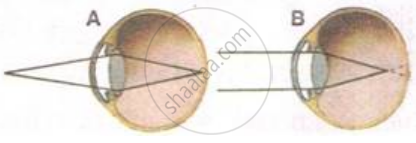Advertisements
Advertisements
प्रश्न
In Myopia the human eye _______.
विकल्प
cannot see nearby objects distinctly
cannot see distant objects clearly
cannot see nearby as well as distant objects clearly
can see nearby as well as distant objects clearly
उत्तर
In Myopia the human eye cannot see distant objects clearly.
संबंधित प्रश्न
Do you know that the corneal-impairment can be cured by replacing the defective cornea with the cornea of the donated eye? How and why should we organise groups to motivate the community members to donate their eyes after death?
About 45 lac people in the developing countries are suffering from corneal blindness. About 30 lac children below the age of 12 years suffering from this defect can be cured by replacing the defective cornea with the cornea of a donated eye. How and why can students of your age involve themselves to create awareness about this fact among people?
A person with a myopic eye cannot see objects beyond 1.2 m distinctly. What should be the type of the corrective lens used to restore proper vision?
The far point of a myopic person is 80 cm in front of the eye. What is the nature and power of the lens required to correct the problem?
the biological/technical terms for the lens of eye losing flexibility resulting in a kind of long-sightedness in middle aged people.
A student is unable to see clearly the words written on the black board placed at a distance of approximately 3 m from him. Name the defect of vision the boy is suffering from. State the possible causes of this defect and explain the method of correcting it.
Name the defect of vision in a person:
whose far point is less than infinity
What is the other name for
hypermetropia
What is the scientific name of
short-sightedness
Name the defect of vision which makes the eye-lens cloudy resulting in blurred vision.
Name the body part with which the terms myopia and hypermetropia are connected.
What is the far point of a person suffering from myopia (or short-sightedness)?
A man can read the number of a distant but clearly but he finds difficulty in reading a book.
From which defect of the eye is he suffering?
Differentiate between myopia and hypermetropia. What type of spectacles should be worn by a person having the defects of myopia as well as hypermetropia? How does it help?
Name the defect of vision which can be corrected by a diverging lens. Show clearly by a ray diagram how the lens corrects the defect.
An eye has a near point distance of 0.75 m. What sort of lens in spectacles would be needed to reduce the near point distance to 0.25 m? Also calculate the power of lens required. Is this eye long-sighted or short-sighted?
A person cannot see the distant objects clearly (though he can see the nearby objects clearly). He is suffering from the defect of vision called:
(a) cataract
(b) hypermetropia
(c) myopia
(d) presbyopia
The near point of a long-sighted person is 50 cm from the eye.
(a) Can she see clearly an object at:
(i) a distance of 20 cm?
(ii) at infinity?
To read a book held at a distance of 25 cm, will she need converging or diverging spectacle lenses?
Enumerate the common defects of vision, their causes and the possible methods of correcting them.
Have a look at the posture of this girl who is reading a book and answer the questions which follow:

Name the problem she is facing.
An old man cannot see objects closer than 1 m from the eye clearly. Name the defect of vision he is suffering from. How can it be corrected? Draw ray diagram for the (i) defect of vision and also (ii) for its correction.
Have a look at the posture of this woman who is reading a book and answer the questions which follow:

What are the two conditions shown in sections A and B of the eye as applicable to her?
Name the common defects of the eye.
Give Reason:
Why do we see clearly in the central region of the retina?
Explain the Term: Hypermetropia
Explain the Term: Astigmatism
Give Technical Term:
The type of lens used to correct myopia is
Mention, if the following statement is True or False
Hypermetropia is a defect of the eye caused due to the eyeball elongation
Nearsightedness: elongated eyeball : : farsightedness: _______
Nearsightedness : concave lens : : farsightedness : _______
Observe the given below the figure, correct it and explain and write about the concept depicted in this figure.

Differentiate the eye defects: Myopia and Hypermetropia
Assertion: Concave mirrors are used as reflectors in torches, vehicle head lights and in search lights.
Reason: When an object is placed beyond the center of curvature of a concave mirror, the image formed is real and inverted.
Which of the following statement is correct?
State reasons for Myopia. With the help of ray diagrams, show the:
- image formation by a myopic eye, and
- correction of myopia using an appropriate lens.
Observe the following diagram and answer questions following it:

- Identify the defect of vision shown.
- List its two causes.
- Name the type of lens used for the correction of this defect.
Match the following:
| Column - I | Column - II |
| 1. Retina | a. Path way of light |
| 2. Pupil | b. Far point comes closer |
| 3. Ciliary muscles | c. near point moves away |
| 4. Myopia | d. Screen of the eye |
| 5. Hypermetropia | e. Power of accommodation |
